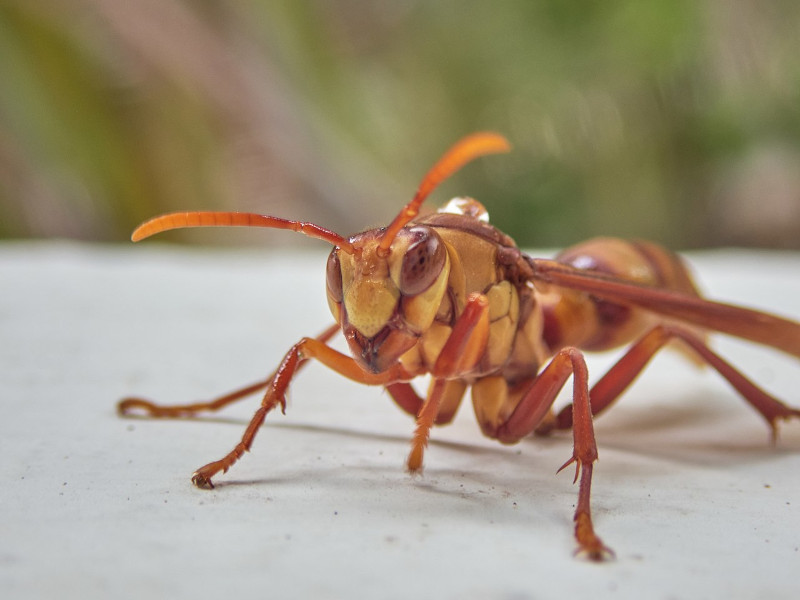
Executioner Wasp Facts
- The most frequently employed common name for this remarkable product of Nature and evolution remains that of the evocative term Executioner Wasp. It does have at least one alternate english title, though. That’s the very similar executioner paper wasp.
- The wasp also has names in numerous other languages across its native range. A few of these translate as hummingbird wasp and brown wasp. Regardless, of which of these one chooses to use when referring to it, it remains an impressive insect.
- Within the scientific community, however, it’s better known by its its technical moniker. Fortunately, that’s a comparatively simple term for the layperson to pronounce. That’s because the invertebrate holds the official term of Polistes carnifex.
- This marvel of evolution received that tag due to the efforts of Johan Christian Fabricius. The respected Danish zoologist, a student of Carl Linnaeus, managed the first recognition of it as a separate and distinct species. He achieved that feat in 1775.
- The awesome Arthropod holds a unique distinction in the annals of science and public opinion alike. That’s due to the nature of its sting. It’s fortunate that it’s not an overtly aggressive species, since it’s sting is considered perhaps the most painful of any insect.
- Thankfully, the amazing Executioner Wasp appears to be continuing to maintain a thriving and stable population base. That pleasant state further seems to hold true throughout its range. The IUCN therefore currently has no listing for it on its Red List.
- The creature nevertheless still faces potential threats to its continued existence as a species. In this, it simply follows a pattern shared by all species on earth today. It, like all forms of life in the world today, faces the peril of habit loss and climate change.
Related Articles
CCL: http://tinyurl.com/4535ecxm
Executioner Wasp Physical Description
The remarkable Executioner Wasp, like most of its relatives, generally captures the attention of those who encounter it. While this occurs for varying reasons, pure size often ranks as one of them. That’s because it’s relatively large compared to closely related wasps.
In that regard, it also presents a pattern of evolution common to many creatures. That’s in the fact that it displays a certain degree of the physiological characteristic of sexual dimorphism. In this instance, that trait manifests in females being larger than the males.
Overall, however, individuals attain body lengths averaging between 1.0 – 1.2 in (2.5 – 3.0 cm). The males tend to be on the lower end of this range, while the females typically measure on the upper end. Exceptional examples nonetheless do occur, regardless of sex.
Its general body structure again follows the pattern shared by its many kindred around the globe. Each has a slender body with a narrow waist, characteristic of most wasp species. Their wings present as translucent and often have a somewhat smoky appearance.
One of the most notable features of the Executioner Wasp is the reddish-orange marking on the upper part of the head of the insect . This sits just above the compound eyes. That’s often described as resembling a mask or helmet, such as those once worn by executioners.
Meanwhile, the coloring of this marvel of Nature varies widely. Some combinations typically dominate, though. These consist of various shades of black, brown, and yellow. The precise patterning differs completely between individuals, like fingerprints among humans.
- Kingdom: Animalia
- Phylum: Arthropoda
- Class: Insecta
- Order: Hymenoptera
- Family: Vespidae
- Genus: Polistes
- Species: P. carnifex
Executioner Wasp Distribution, Habitat, and Ecology
The fascinating Executioner Wasp evolved as native to an extremely broad swathe of the surface of the earth. The full extent of that natural zone of habitation might surprise you, however. That’s true since that range extends from South America to North America.
In the southern portion of its range, the Arthropod inhabits virtually the entire continent, down to the upper portions of Argentina. Northward, it also appears in all of the countries of Central America. In the United States, it’s also seen in Arizona and southern Texas.
Nature blessed this impressive wasp with a high degree of adaptability regarding its choice of habitat. It’s therefore seen in a wide range of local environments. These range from forests, both deciduous and evergreen, to numerous kinds of urban areas, including yards.
The species does display a strong preference for open areas, as well as those possessing higher levels of humidity. In parts of its range, this includes near the coast. While it does favors high humidity levels, it prefers wooded areas without frequent heavy rainstorms.
Like others of its kind, known as paper wasps, the Executioner Wasp lives as a eusocial species. It lives in small colonies, founded by a single queen. Nests are constructed by chewed wood pulp, and generally remain small, rarely supporting more than 13 adults.
The insect primarily feeds as a carnivore. The majority of its diet consists of various small insects and other arthropods. Some of its prey include such species as caterpillars and spiders. It’s also believed, however, that it also consumes smaller amounts of plant nectar.
Species Sharing Its Range
Check out our other articles on 4 Captivating Marine Crabs, Southern Elephant Seal, Great Barrier Reef, Eastern Sweetshrub, Tiger Shark, Spiked Magician, Rose’s Ghost Frog, Black Mamba
